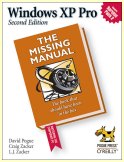 |
| About IR |
| Editors |
| Author instructions |
| Copyright |
| Author index |
| Subject index |
| Search |
| Reviews |
| Register |
| Home |
Managing Windows XP
Pogue, D., Zacker, C. & Zacker, L.J. Windows XP Pro: the missing manual. 2nd. ed. Sebastopol, CA: O'Reilly, 2004. xii, 689, [1] pp. ISBN 0-596-00898-8 $29.95, £20.95
It's inevitable, I suppose that no one can produce a flawless operating system - even the lauded Linux is prey to problems; I understand that Red Hat recently issued a set of 183 patches in one block - but I must say that I seem to have had more problems with Windows XP than I did with NT 4 for Workstations. Just recently, I was glad to have this book (and (another reviewed earlier) on my desk, since they helped me to deal with a couple of those problems, by pointing me to tools and techniques that would help. The two are complementary; for example, the 'Missing manual' has no index entry for 'memory' or 'RAM', whereas Galla's book has a section devoted to the subject.
The 'Missing manual', which is an excellent concept generally, and we have already reviewed those on Google and Dreamweaver. Given the complexity of programs these days, producing a paper manual would be enormously costly and, instead, we have to rely upon the help system, which is not always an appropriate solution. The 'Missing manual' is a step towards a solution but falls a little short because, even in almost 700 pages, it is impossible to cover much more than the basics of Windows XP Pro.
There are six sections to the book dealing with the Windows XP desktop; its components; working on the Internet with XP; 'plugging into Windows XP', which deals printing, aspects of hardware, compressing and encrypting files, and maintenance tasks; networking; and appendices, covering installation, the menu system and 'fun with the registry' - some people have strange ideas of 'fun'!
I found numerous good ideas in the book such as increasing the start-up speed by getting rid of some the cosmetic features of XP and adopting the 'old' Windows Start-up menu; using the Search function in Windows Explorer to search the Internet, rather than simply your hard disc, and changing the preferences to use Google rather than MSN Search; the whole of Chapter 7, dealing with pictures, sounds and movies; 'chatting' using Windows Messenger; how to get into and use 'Safe Mode'; performing a 'System Restore' (which I've had to do twice, recently); and many more.
The book is very well produced, as is generally the case with O'Reilly products, with a variety of techniques for drawing attention to important points: it is very well illustrated, and the greyscale images are fine for the purpose. On the Website, you will also find the 'Missing CD-ROM' for the book - a nice idea. Recommended.
Professor Tom Wilson
Editor-in-Chief
February, 2005
How to cite this review
Wilson, T.D. (2005). Review of: Pogue, D., Zacker, C. & Zacker, L.J. Windows XP Pro: the missing manual. 2nd. ed. Sebastopol, CA: O'Reilly, 2004. Information Research, 10(3), review no. R167 [Available at: http://informationr.net/ir/reviews/revs167.html]